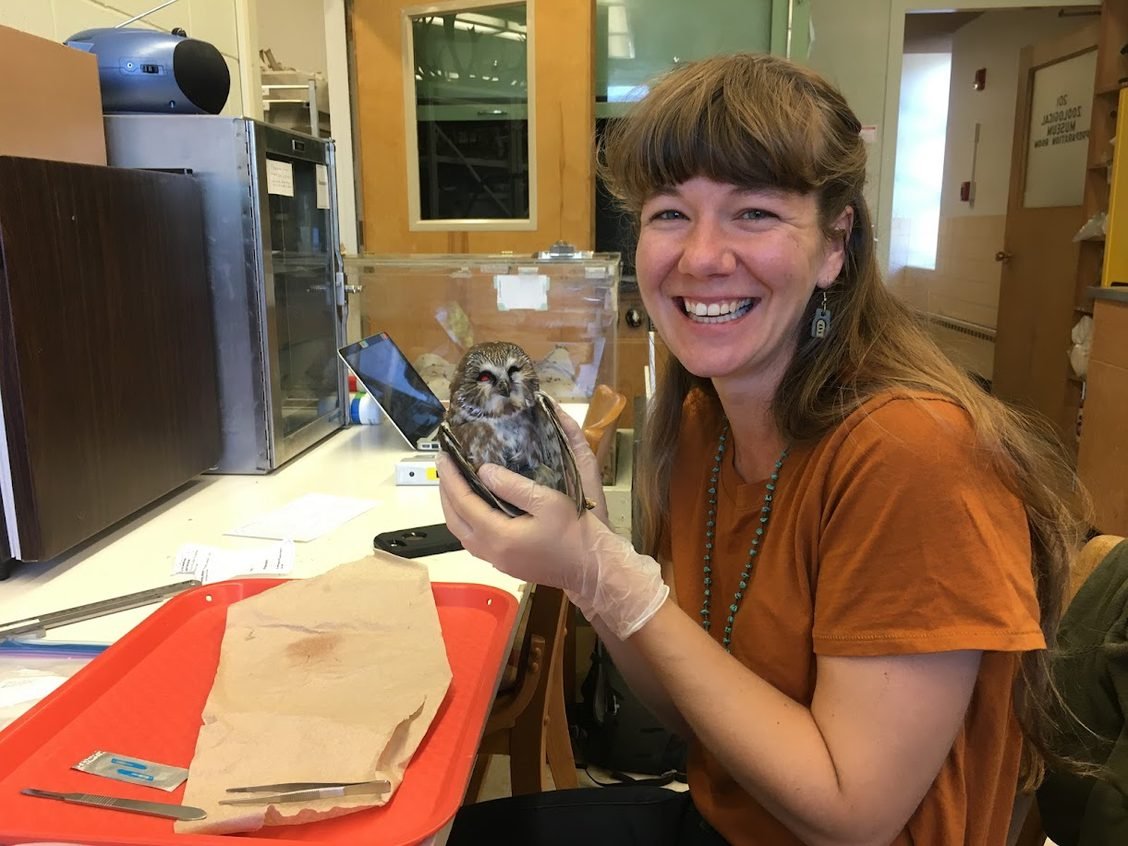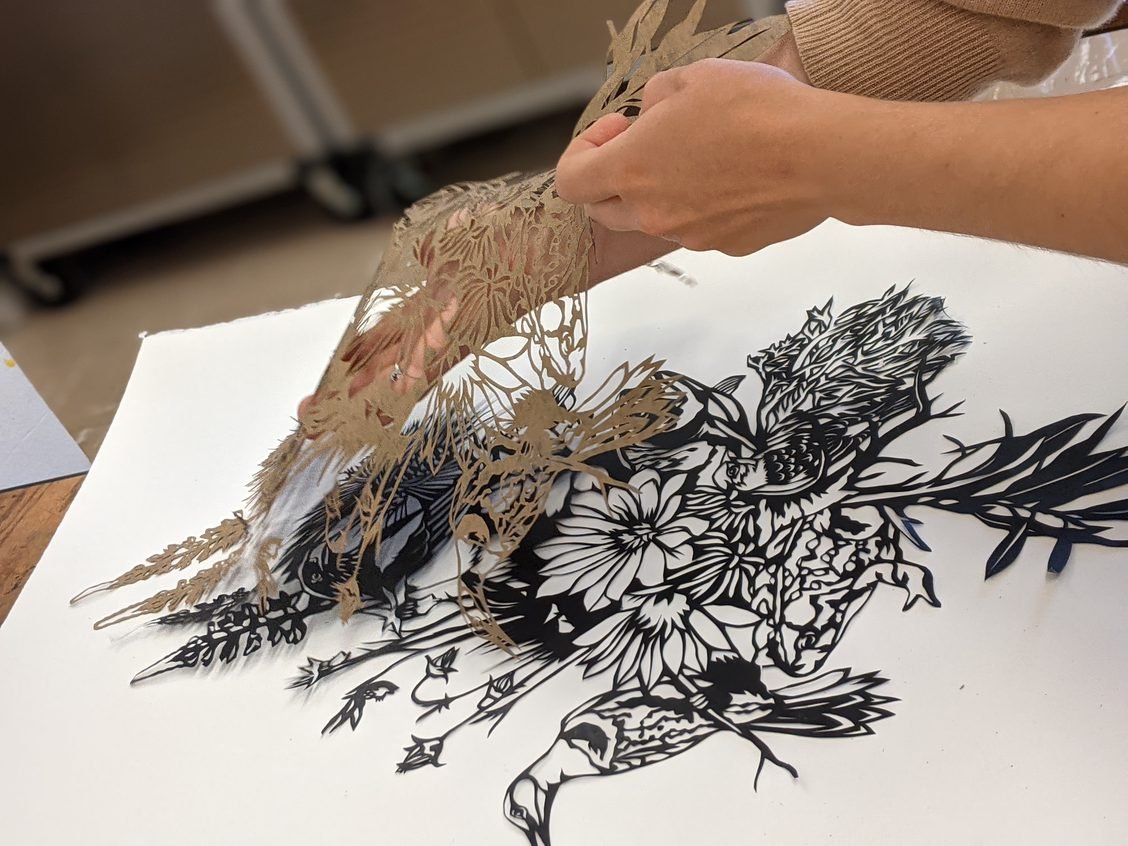Emily Schubert: NOURISH
2021 Artist-in-Residence at Rattlesnake Creek Dam
How was your experience as an Open AIR Artist-in-Residence?
My time as an Artist-in-Residence with Open AIR was a breath of hope and fresh air - literally! Getting to be based at the Rattlesnake Creek Dam restoration site was a dream come true. There was something so terribly special about getting to be one of the last humans to inhabit a space before it is more widely restricted to humans for the sake of rewilding and species return. I spent my time during the residency immersing myself in the site, in the local flora and fauna, and gathering natural materials from the site to make work. Time flew by in a productive frenzy, but I was also able to take time to meditate, explore, and connect to western Montana in a true, open way.
What was your research process during this time?
My research involved spending a lot of time at the dam site, watching, waiting, and collecting. I did my best to learn the names of most of the plants used to re-establish the site. I researched what animals lived in the area that were affected by the building of the dam - Westslope Cutthroat trout, Bull trout, Western Toads - and took note of what species seemed to be slowly returning - spotted sandpipers, magpies, a western toad! I collected bits of natural materials to incorporate into my work like pine needles, Ponderosa bark, wolf lichen and other mosses. I mostly waited for the landscape to tell me some stories and then thought about how to turn those stories into an interactive experience with puppets. I also chose to focus on materials and play and see what came out of it. I grew more interested in the sense of home a human can feel in the natural world, close to the earth, especially in areas where the earth is in a healing communion with humans who are trying their best in ways they know to help the planet heal itself.
What are you up to now (post Open AIR)?
Post residency I moved to a new city with my partner and now I’m slowly discovering and exploring Pittsburgh. Most of my life since Open AIR has been in transition and I’m just beginning to find my way back to the studio and carve out time to make and think. There have been plenty of projects - furniture building, clothes mending, soap making but I have yet to truly settle back into my art practice. This period of rest from making work has allowed me time to process a lot of what I experienced this past year and I am excited to bring many of the ideas in my head to fruition at some point in the future.
Have your material choices changed over the years?
I would say that much of the material I use is found, collected, thrift, or preexisting in some way. Raw materials are usually more expensive and lack history which I personally think adds a layer of complexity to any work of art. It was something and now it is something else or part of something else and that intrigues me in its relationship to the “ongoingness” of objects in time. I have realized more and more recently that I am in a period of reconsidering or reevaluating my use of materials in terms of my relationship to the planet and my general relationship to stuff and “supplies” as a person who works in many different media. In some ways I am shifting in a direction that utilizes more materials collected from the natural world - the bones, sticks, burls, pine needles, rocks and mosses - because it feels better. Because it feels like then I’m somehow making work in collaboration with the natural world around me, the world to which that work, like my body, will return to as dust or compost, or fodder for mushrooms, at some point in a future I can’t see, hopefully.. In other ways I am still trying to figure out how to justify the use of aerosol spray adhesives and hot glue but I think there is something that has shifted about the intentional behind my choice of material - it is no longer simply “is it affordable and will it help me accomplish the vision” It is “how is this choice in alignment with my goal to inspire myself and others help the planet and the humans on it heal.”
What led you to work 2D/3D?
I recently realized (thanks to the internet) that the quote “jack of all trades, master of none” is actually only the first part of the whole quote which goes “jack of all trades, master of none, but oftentimes better than a master of one.” And something about this discovery has changed my whole perspective about being an interdisciplinary artist working in many different mediums because I am often overcome with a feeling as a maker that I am simply too broadly interested in too many different ways of making to convey the messages I want to convey. This feels like it applies to this question because I work both in 2D and 3D but I view them very separately in my mind. Most of my 2D work is collage and paper-cut. The collage satisfies my need to get across ideas, feelings, or emotions quickly and the paper-cutting becomes a sort of meditation on a thought or idea that permeates the whole story I am trying to tell through the paper-cut crankies (scrolling shadow plays) I make. Something about these two 2D modes of making satisfies a specific part of me that I feel influences in some way the 3D work I make– sometimes the 2D even evolves to include 3D work or more performative work like many of the crankies do. 3D work is definitely where I feel the most comfortable as a maker. My brain sees things existing in space and so I have always gravitated towards building and sculpture whether it be wearable, or a puppet or a free standing object.
Can you talk about the difference between being a maker/director of your own work and being a viewer?
As a maker of objects and performing objects I am often making work with a story, message, or simple idea in mind that I am trying to communicate to the viewer with enough open space or open endlessness in that story, message or idea for the viewer to project upon it their own thoughts, beliefs, and emotions and get something valuable out of their experience. I am mostly trying to create out-of-the-ordinary moments that inspire something outside of the everyday - a thought you’ve never quite put words to, a perspective you’ve never before experienced or shared, an imagining of sorts. As a human equally weighed down by much of the heaviness society, culture, and politics brings with it I have, in a way, taken it upon myself to keep people of all ages imagining - something different, something better, something other than. As a viewer of other artists’ work, I think I am looking for the messages, meanings, and emotions. I want to experience something extra-ordinary. I want to be (and am so often) moved and I want the experience to be expansive. That’s why I seek out looking at art and seeing live theater. I want to expand in collaboration with another’s thought process, way of working, way of being -it facilitates another level of connection. It makes me think of the Jungian psychologist James Hollins question: “Will this enlarge me or diminish me?” Art is meant to enlarge.
See more of Emily’s work at www.emily-schubert.com






